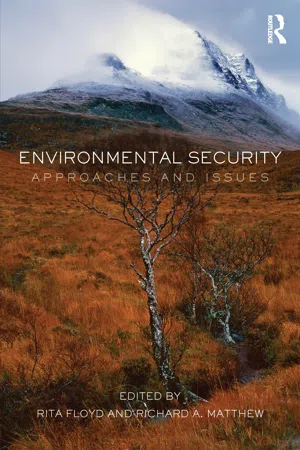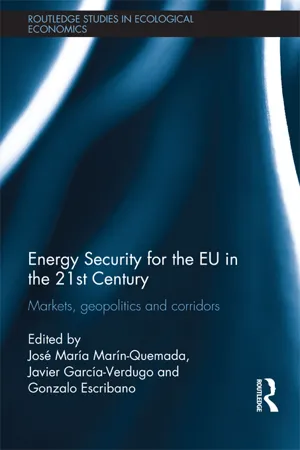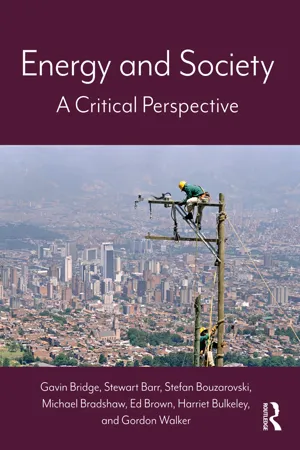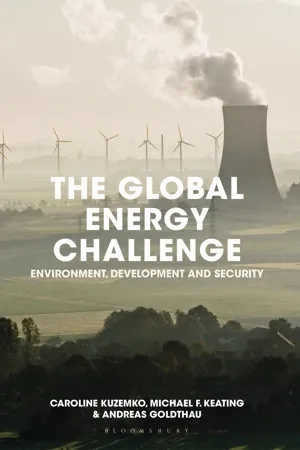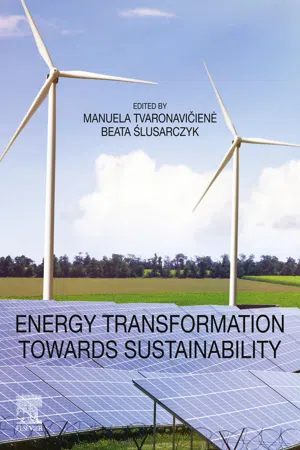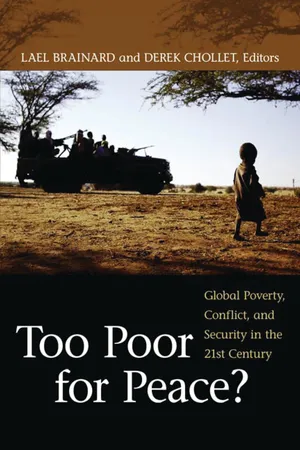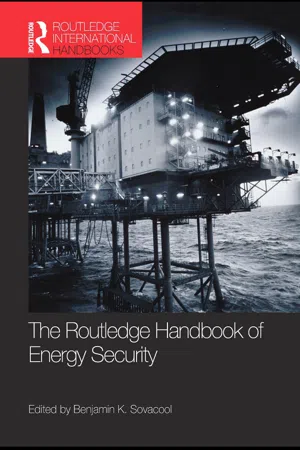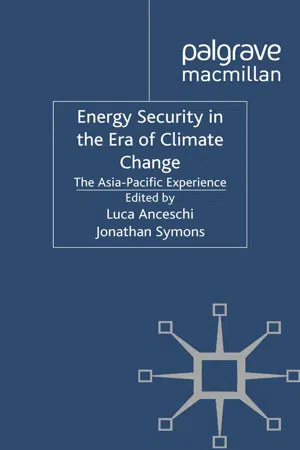Geography
Impact of Energy Insecurity
The impact of energy insecurity refers to the negative consequences resulting from a lack of reliable access to energy resources. This can lead to economic instability, social inequality, and environmental degradation. Energy insecurity can also exacerbate geopolitical tensions and hinder sustainable development efforts.
Written by Perlego with AI-assistance
Related key terms
1 of 5
8 Key excerpts on "Impact of Energy Insecurity"
- eBook - ePub
Environmental Security
Approaches and Issues
- Rita Floyd, Richard Matthew, Rita Floyd, Richard Matthew(Authors)
- 2013(Publication Date)
- Routledge(Publisher)
In this situation it becomes pertinent to ask what is actually being secured by the project. Unfortunately, despite government protestations to the contrary, it is often the financial security of governing and business elites that determines project decision making at the expense of local communities’ environmental security. In addition, due to the transnational nature of these energy projects the professed pursuit of energy security in one relatively affluent state may cause environmental and energy insecurities in another. 54 This critical security studies focus on the most marginalized communities has some similarities with an emerging ‘energy poverty’ concept. Energy poverty From a security studies perspective Ciuta argues that, ‘the story of energy security is relatively straightforward … energy in security is the product of the contradiction between a general trend of increasing energy consumption and a contradictory trend of decreasing energy reserves.’ 55 This definition, however, assumes national or global concerns and a focus on the relatively affluent. In the case of many communities in the South ‘increasing energy consumption’ in their communities is not part of the problem at all. A critical approach to energy security could therefore link energy insecurity to ‘energy poverty’, which avoids the state-centric assumption through a direct focus on households - eBook - ePub
Energy Security for the EU in the 21st Century
Markets, Geopolitics and Corridors
- José María Marín Quemada, Javier García-Verdugo, Gonzalo Escribano(Authors)
- 2012(Publication Date)
- Taylor & Francis(Publisher)
1 but to reach an agreement on a valid and useful definition is not a simple task. Energy security is a multidimensional concept comprising technical, economic, social, environmental and geopolitical issues in close interaction.The geopolitical relations derived from the geographical distribution of energy resources (see Chapter 1 ) can be described as a complex system of interdependent producers, consumers and transit countries. Energy interdependence is an asymmetric relationship in the short term, because a temporary energy supply interruption is less costly for the provider; the asymmetry disappears in the long term. Producers cannot usually forego for a long time the foreign currency inflows from energy exports because they are quite dependent on them for their economic growth and for their political and social stability.Therefore, the concept of energy security is relevant for countries that are net importers of energy as well as for exporting countries. However, the present study focuses on the energy security of the EU, and it shall concentrate accordingly on energy risk for consumer countries using an economic and geopolitical focus. For this reason, the term ‘energy security’ should be understood as equivalent to ‘security of energy supply’ throughout the book. However, the other dimensions of energy security will appear now and again in different parts of the text and will be examined more thoroughly in Chapter 7 - eBook - ePub
Energy and Society
A Critical Perspective
- Gavin Bridge, Stewart Barr, Stefan Bouzarovski, Michael Bradshaw, Ed Brown, Harriet Bulkeley, Gordon Walker(Authors)
- 2018(Publication Date)
- Routledge(Publisher)
E nergy can be so fundamental to human well-being that serious consequences may result when adequate access to its associated services cannot be achieved. This chapter examines the circumstances and processes through which patterns of energy deprivation are produced in different parts of the world, focusing in particular on the settings of home, household and community. The main framings through which problems of inadequate energy access have been examined to date are introduced (energy and fuel poverty, vulnerability) while drawing out their differences and connections; the geographical variability in how these problems are experienced and understood is also stressed. The chapter also examines the different consequences of inadequate access to energy services (and their geographies), in addition to providing a critical interrogation of the informal and formal amelioration strategies that are utilised and developed in this context. This leads to a discussion of the relationship between energy equity and key determinants of quality of life, so as to highlight the benefits brought about by adequate levels of energy use. Our review of energy poverty and vulnerability is situated within a broader consideration of the political, institutional and infrastructural underpinnings of marginality in the global North and South alike. We recognise the problems involved in using dualisms like developed/developing, rich/poor and even global North/global South. However, alternative formulations (like low-and-middle income countries) also have significant limitations. For this reason, we have adopted global North and South in this chapter and throughout the book as a shorthand for describing enduring structural inequalities at the global scale (for a reflection on the politics of labels, see Silver 2015).In its entirety, the chapter aims to connect the causes and consequences of energy deprivation with current developments at the global scale. Using energy services in the home as a lynchpin, it outlines the key components that contribute to inequalities in energy consumption: questions of energy access , energy affordability , energy efficiency and house hold needs. The chapter also discusses the dominant definitions of fuel and energy poverty , while outlining their comparative advantages and shortcomings. Sensitive to the profoundly different circumstances of energy deprivation in different parts of the world, the chapter aims to move beyond the overly simplistic dualistic global North–global South framings that dominate mainstream understandings of the underlying driving forces and socio-economic implications of the dynamics of energy inequality. In doing this, the chapter builds on the notion of multiple/overlapping rhythms and technologies of energy use in the home, initially suggested in Chapter 3 - eBook - PDF
The Global Energy Challenge
Environment, Development and Security
- Caroline Kuzemko, Andreas Goldthau, Michael Keating(Authors)
- 2017(Publication Date)
- Red Globe Press(Publisher)
The likelihood of such events occurring is determined by factors such as the age of components, the precision and quality of the manufacturing process, maintenance regimes, operating conditions and environmental variables such as wind speeds and temperature. In this sense, energy security can be understood as a property of any given energy system – like the electricity grid system or the fossil fuel regime. Insecurity of supply might result, therefore, from the impact of natural dis-aster or from human error within technical systems, as much as from external geopolitical events like transit disputes or military conflicts. This leads to a very different understanding of the elements that need to be in place to ensure energy security. Furthermore, it suggests that problems with energy systems might occur more often than had otherwise been envisaged. In 2005, for example, Hurricane Katrina rendered inoperable significant amounts of US oil production, with knock-on effects for international markets and pricing. In 2006/2007, an unusually cold winter in the United Kingdom saw gas supplies run low – making it hard to guarantee supply at peak times. Technical changes 154 The Global Energy Challenge to the UK energy system, such as ensuring greater gas storage capacity, were then proposed as necessary measures to ensure UK energy security. There is emerging research from a more technical school of thought that poses questions about traditional conceptions of energy supply security. It is suggested that many centralised electricity systems (national grids) require far too much spare capacity in order to meet set minimum (regulated) energy security standards. This reflects the extent to which energy security is conflated with security of supply, such that when governments start worrying about the lights ‘going out’, they see building yet more generation capacity as the solution (Hoggett et al. 2013 ). - eBook - ePub
- Manuela Tvaronaciene, Beata Slusarczyk(Authors)
- 2019(Publication Date)
- Elsevier(Publisher)
Energy Charter Secretariat, 2015 , p. 16). This is a very similar definition as that of importing countries, and has no elements relating to energy transit in the country. Ukraine's policy measures for energy security are therefore similar to the ones of importing countries.Geopolitics of energy dependencies
Since the industrial revolution, the geopolitics of energy, including who supplies it and securing access to those supplies, has been a driving factor in global security and prosperity (Pascual, 2008 ). The energy geopolitics is shaped by both the size and location of own and other natural resources, how available they are, who controls them, their cost, alternative transportation routes, how regional and global markets balance, market mechanisms and regulations, political decisions, and prices in general. Furthermore, due to intertwined national and international energy issues, there are different stakeholders, including state and nonstate, which affect political outcomes. The geopolitical role of a country is influenced by the scale and scope of the dependence it represents for other actors (businesses, countries) (Pascual, 2008 ). Resources affect national policy making by acting upon domestic actors, which in turn affect the domestic political system through associations, state structure, and ideology and, hence, business-to-business and business-to-government relations, must be included in the analysis (Austvik and Lembo, 2017 , p. 663–666). Energy and geopolitics have been closely linked in both old and new formulations. Countries have made and make national strategies and geostrategies to meet their energy needs, reach markets, and secure national positions and interests. The securitization of energy policy has contributed to the development of national security policies.In recent decades, climate change concerns and growing debates on decarbonization have added to the politicization of the energy sector and created worldwide pressures and policies for improved energy efficiency, more renewable energy, and less dependence on fossil sources. The climate debate has contributed to the complexity of the energy industry, not least because fossil energy represents as much as 87% of world energy usage and is the main source of global CO2 emissions (Cusick, 2013 - eBook - PDF
Too Poor for Peace?
Global Poverty, Conflict, and Security in the 21st Century
- Lael Brainard, Derek Chollet, Lael Brainard, Derek Chollet(Authors)
- 2007(Publication Date)
- Brookings Institution Press(Publisher)
Climate change is a pressing poverty issue. It can nullify efforts to secure meaningful and sus-tainable development in poor communities and countries. 21 Climate change could ruin whatever modest gains that poor countries, particularly in Africa, have achieved in the past decades. No other single issue presents such a clear and present danger to the future welfare of the world’s poor. 22 Case Studies of Environmental Insecurity Hot Spots This section reviews two case studies of resource-related environmental inse-curities and eventual conflicts. Although both studies illustrate armed con-flicts and what have turned out to be major international and humanitarian disasters, the goal here is to bring out the role that resources have played in threatening environmental security and precipitating such disasters. Both studies illustrate a typical relationship between humans and resources and typify resource greed exacerbated by resource scarcity. The first case study, on the environmental insecurity that led to the well-known Rwandan genocide, is a result of what Homer-Dixon refers to as “resource capture.” 23 This is a situation in which a fall in the quantity and quality of renewable resources combines with population growth to encour-age powerful or advantaged groups within a society to shift resources in their favor, usually producing acute environmental scarcity for poorer and weaker Resource and Environmental Security 79 groups whose claims to resources are opposed by the much stronger groups, leading to conflicts. - eBook - ePub
- Benjamin K. Sovacool(Author)
- 2010(Publication Date)
- Routledge(Publisher)
These links are generally based on the assumption that societies can become stressed to the point of collapse when environmental conditions deteriorate to the point that necessary resources are unavailable, 3 Significantly, however, long before we run out of resources, people will start fighting over what is left. As demonstrated by this chapter, the unchecked growth in fossil energy consumption and the ensuing acceleration of global climate change, as well as related air and water pollution, act as “threat multipliers” impinging on energy security worldwide. 4 These three environmental dimensions are just a subset of a larger array of environmental concerns that threaten energy security, including land pollution, forestry, and biodiversity loss. This broad range of threats to energy security requires a holistic treatment of causes and effects, including energy and climate issues as well as waste, agriculture, water, and forestry. 5 For example, the land required for energy production can compete with food production, leading to tension and instability. This chapter links three of these environmental dimensions to energy security and suggests a range of metrics. In particular, it focuses on the “threat multipliers” that climate change, air pollution, and water issues add to the energy security challenge, as well as possible mitigation strategies - eBook - PDF
Energy Security in the Era of Climate Change
The Asia-Pacific Experience
- L. Anceschi, J. Symons, L. Anceschi, J. Symons(Authors)
- 2016(Publication Date)
- Palgrave Macmillan(Publisher)
Directing our attention instead to the hybrid agencies that assemble heterogeneous ele- ments, hopefully avoids the bias that inevitably results in one-sided research endeavours and destructive or infeasible policy agendas, which have helped to bring about the Anthropocene era in the first place. Assembling energy security Energy security is commonly understood as ‘simply the availability of suffi- cient supplies at affordable prices’, that is, a variable of national economic growth to be secured through markets, political and, if necessary, military action. By extension, political and scholarly concern with energy security is premised on threats to the smooth functioning of national economies aris- ing from sharp increases in prices, instability in oil-producing countries or geopolitical tensions. As such, hydrocarbon resources in general, and oil and gas reserves in particular, 8 are deemed the ‘lifeblood of civilization’; for this reason, they are a central preoccupation of national security agendas (Zweig and Bi, 2005; Amineh and Houweling, 2007; Marquina Barrio, 2008; Moran and Russell, 2009). Maximilian Mayer and Peer Schouten 21 While specific national energy security strategies may diverge as export and import countries follow diverging interests and strategic policies appear to compete with market-based approaches, their similarities by far outweigh their differences. The basic assumptions have remained constant over time. The standard contemporary understanding of energy security has not devi- ated from the canonical definition offered by the US Department of Energy in 1985 (as cited in Hirsch, 1987, p. 1472): Energy security means that adequate supplies of energy at reasonable cost are physically available to US consumers from both domestic and for- eign sources. It means that the nation is less vulnerable to disruptions in energy supply and that it is better prepared to handle them if they should occur.
Index pages curate the most relevant extracts from our library of academic textbooks. They’ve been created using an in-house natural language model (NLM), each adding context and meaning to key research topics.
